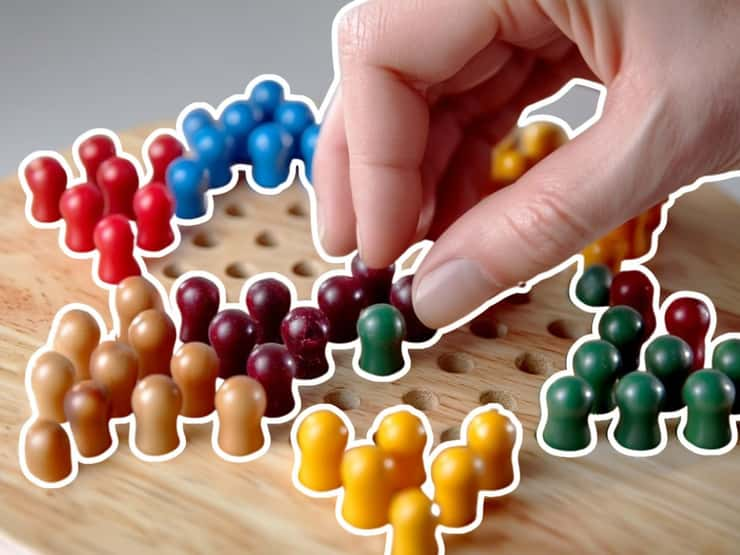Chinese Checkers
Learn how to play Chinese Checkers with simple rules, special strategies, and fun variations for 2–6 players.
✍️ September 10, 2025
- 🎴 How to Play Chinese Checkers
- 🃏 Chinese Checkers Special Rules
- 🎯 Chinese Checkers Variations
- 👾 FAQs about Chinese Checkers
Chinese Checkers is all about racing marbles across a star-shaped board, hopping and blocking your way to victory. It looks simple at first glance, but once the jumps start chaining together, things get heated fast.
Whether you’re playing a chill two-player match or a full six-player showdown, the game balances strategy and chaos in equal measure. If you’re curious about how to play Chinese Checkers the right way, here’s everything you need to know—without the fluff.
👉 Feeling nostalgic? Ludo Drinking Game turns a childhood favorite into a wild, shot-filled showdown.
How to Play Chinese Checkers
At its core, the goal is simple: get all your marbles from your triangle to the opposite one before anyone else does. But the way you move makes the game exciting.
1. Set up the board
Each player picks a colored triangle and fills it with 10 marbles. You can play with 2–6 people, leaving some triangles empty if fewer are playing.
2. Decide who starts
Flip a coin, roll a die, or let the youngest player go first. Turns move clockwise.
3. Take your move
On your turn, move one marble either to an adjacent hole or hop over another marble into an empty space.
4. Chain jumps
You can hop over multiple marbles in one turn if there’s space to land after each jump. This is how you really cover ground fast.
5. Stay within the board
Marbles can only move along the board’s holes—no shortcuts off the edges!
6. Winning the game
The first player to move all their marbles into the opposite triangle is crowned the winner.
👉 Into strategy and revenge? Spite and Malice is a cutthroat card game where blocking your opponent is half the fun.
Chinese Checkers Special Rules
While the basics are straightforward, a few special rules keep the game fair and strategic.
1. No double hops over clusters
You can’t jump over two marbles side by side in a single move—only one at a time.
2. Blocking is allowed (sort of)
Players can block paths by sitting on key spaces, but house rules often allow swapping out if someone’s final marble is permanently stuck.
3. Multi-color play
In some versions, players control two sets of marbles, making the game more strategic.
Chinese Checkers Variations
Chinese Checkers adapts depending on the number of players or house rules. Here are some fun twists to try.
1. Two-Player Power Play
With fewer players, you can use two or even three sets of marbles each to make the board busier and gameplay longer.
How to play Two-Player Power Play
- Each player controls 2–3 colors.
- Move marbles just like the standard game, but manage multiple triangles.
- First player to get all their marbles home wins.
2. Speed Checkers
For a faster game, this variation cuts down the marbles.
How to play Speed Checkers
- Each player only uses 6 marbles instead of 10.
- Objective stays the same: reach the opposite triangle.
- Because there are fewer pieces, turns move quickly and games end faster.
3. Team Play
Perfect for 4 or 6 players, where teamwork becomes part of the fun.
How to play Team Play
- Two players team up and share victory if both manage to move their marbles across.
- Partners can strategically block opponents or open paths for each other.
- Communication is key—but don’t give too much away!
FAQs about Chinese Checkers
1. How many players can play Chinese Checkers?
Anywhere from 2 to 6 players.
2. Do I have to jump if I can?
No, unlike Checkers, jumping is optional in Chinese Checkers.
3. Can I hop over my own marbles?
Yes, you can hop over both your own and your opponents’ pieces.
4. What happens if someone blocks my last space?
House rules vary—some allow swapping the blocking piece, others say tough luck.
5. Is Chinese Checkers really from China?
Nope! It was invented in Germany in 1892 and rebranded with the “Chinese” name as a marketing move. \